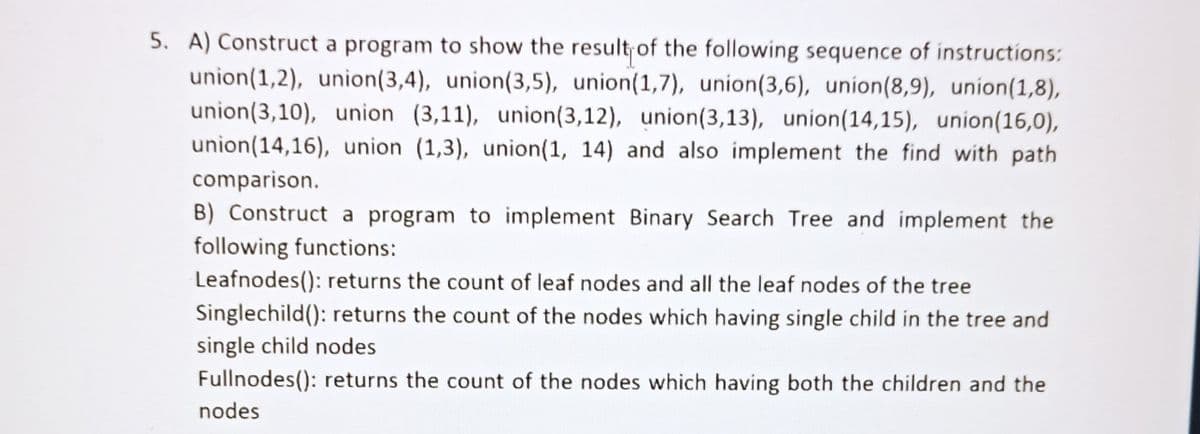5. A) Construct a program to show the result of the following sequence of instructions: union(1,2), union(3,4), union(3,5), union(1,7), union(3,6), union(8,9), union(1,8), union(3,10), union (3,11), union(3,12), union(3,13), union(14,15), union(16,0), union(14,16), union (1,3), union(1, 14) and also implement the find with path comparison.
5. A) Construct a program to show the result of the following sequence of instructions: union(1,2), union(3,4), union(3,5), union(1,7), union(3,6), union(8,9), union(1,8), union(3,10), union (3,11), union(3,12), union(3,13), union(14,15), union(16,0), union(14,16), union (1,3), union(1, 14) and also implement the find with path comparison.
C++ for Engineers and Scientists
4th Edition
ISBN:9781133187844
Author:Bronson, Gary J.
Publisher:Bronson, Gary J.
Chapter1: Fundamentals Of C++ Programming
Section1.4: Preliminary Four: Algorithms
Problem 6E: (Numerical) a. Write a set of detailed, step-by-step instructions in English to calculate the fewest...
Related questions
Question
5th question A

Transcribed Image Text:5. A) Construct a program to show the result of the following sequence of instructions:
union(1,2), union(3,4), union(3,5), union(1,7), union(3,6), union(8,9), union(1,8),
union(3,10), union (3,11), union(3,12), union(3,13), union(14,15), union(16,0),
union(14,16), union (1,3), union(1, 14) and also implement the find with path
comparison.
B) Construct a program to implement Binary Search Tree and implement the
following functions:
Leafnodes(): returns the count of leaf nodes and all the leaf nodes of the tree
Singlechild(): returns the count of the nodes which having single child in the tree and
single child nodes
Fullnodes(): returns the count of the nodes which having both the children and the
nodes
Expert Solution
This question has been solved!
Explore an expertly crafted, step-by-step solution for a thorough understanding of key concepts.
This is a popular solution!
Trending now
This is a popular solution!
Step by step
Solved in 2 steps with 2 images

Knowledge Booster
Learn more about
Need a deep-dive on the concept behind this application? Look no further. Learn more about this topic, computer-science and related others by exploring similar questions and additional content below.Recommended textbooks for you

C++ for Engineers and Scientists
Computer Science
ISBN:
9781133187844
Author:
Bronson, Gary J.
Publisher:
Course Technology Ptr

C++ Programming: From Problem Analysis to Program…
Computer Science
ISBN:
9781337102087
Author:
D. S. Malik
Publisher:
Cengage Learning

C++ for Engineers and Scientists
Computer Science
ISBN:
9781133187844
Author:
Bronson, Gary J.
Publisher:
Course Technology Ptr

C++ Programming: From Problem Analysis to Program…
Computer Science
ISBN:
9781337102087
Author:
D. S. Malik
Publisher:
Cengage Learning